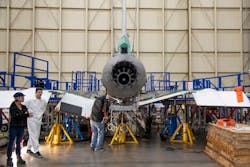Lockheed's Skunk Works installs GE engine on NASA's X-59 supersonic aircraft
PALMDALE, Calif., - NASA's X-59A Quiet Supersonic Technology aircraft, or QueSST, now has its F414-GE-100 turbofan engine, another important step toward its first flight, which is currently scheduled to take place next year. Lockheed Martin's Skunk Works advanced projects division is building the experimental X-59A, which will be used to explore sonic-boom-mitigating technologies that could significantly affect the future of supersonic flight, particularly in the commercial realm, Joseph Trevithick reports for The War Zone. Continue reading original article.
The Military & Aerospace Electronics take:
17 November 2022 - The installation of the F414-GE-100 engine took place at Lockheed Martin’s Skunk Works facility in Palmdale, California, earlier this month, marking a major milestone as the X-59 approaches the completion of its assembly.
The 13-foot-long engine from General Electric Aviation packs 22,000 pounds of propulsion energy and will power the X-59 as it flies at speeds up to Mach 1.4 and altitudes around 55,000 feet. The X-59 team will follow the aircraft’s assembly with a series of ground tests and ultimately, first flight in 2023.
NASA’s X-59 is the centerpiece of the agency’s Quesst mission. The aircraft is designed to reduce the sound of sonic booms, which occur when an aircraft flies at supersonic speeds, to a quiet sonic “thump.” This will be demonstrated when NASA flies the X-59 over communities around the U.S. starting in 2025, with the goal of providing the data necessary to open the future to commercial supersonic flight over land, greatly reducing flight times.
Related: NASA's X-59 aims to open the skies for new supersonic airliners
Related: World’s fastest airliner ‘Overture’ to usher in new era of supersonic travel
Related: NASA seeks supersonic commercial air travel concepts
Jamie Whitney, Associate Editor
Intelligent Aerospace
